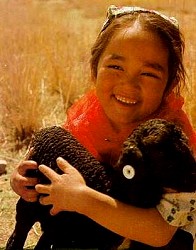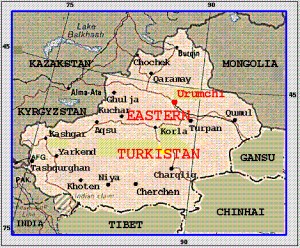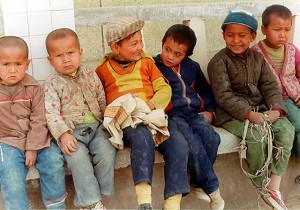|
N 3-4, 18.04.2000
UYGURS – GLORIOUS PAST AND SAD PRESENT
7,2 millions of Uygurs live in Xinjiang Uygur autonomous region, comprising 47% of the region's population. About 1 million Uygurs are scattered in nearby countries, Europe and USA. Besides Uygurs there also live other Turkic peoples – Kazakhs, Uzbeks, Kyrgyzs, Tatars. There are also Tadjiks, Hui (one of 10 Muslim ethnic minorities from total 55 in China; Hui language is Mandarin Chinese) and Hans (properly Chinese). Uygurs are supposed to be the direct descendants of the Huns. The name “Uygur” is mentioned in the Chinese chronicles of the third century B.C. Ancient Greek, Iranian, and Chinese sources of those times placed Uygurs and their tribes, and sub-tribes in the vast area between the Yellow River, Eastern Turkestan and the Mongolian steppes.
The Uygurs established their first state in 744, with the city of Karabalgasun, on the banks of the Orkhun River, as its capital. The founder of this Uygur state was Kutluk Bilge Kul Khagan. In 751, the Chinese army was disastrously defeated at the battle of Talas River by the Arabs, Tibetans, and the Uygurs. Later the Uygurs helped the Tang Dynasty, which paid them a tribute, in restoring order in China. In 805 A.D. the Uygur state began to disintegrate. In 840 the Kyrgyz attacked the tottering state, killed the Khagan. After the fall of the first Uygur empire, a group of Uygurs emigrated to the west banks of the Yellow River. Now their descendants are called yellow Uygurs or Yugurs. A second group emigrated via Yetti Su (Seven Rivers) to the Southern part of Tianshan in Eastern Turkestan. The largest group emigrated to the northern part of Tianshan. The yellow Uygur (Yugur) kingdom was absorbed in 1228 by the Tankuts and later became a part of the Mongol empire. The Yugurs are lamaists. The Uygurs living in the northern part of Tianshan Mountains established the Karakhoja Uygur Kingdom near the present day city of Turfan (Turpan), in 846. The Uygurs living in the southern part of Tianshan Mountains established the Karakhanid Uygur Kingdom in 840, with Kashgar as its capital. Beside Uygurs there also lived Turkic clans of the Karluks, Turgish and the Basmils. In 934 the Karakhanids embraced Islam, whereas the Karakhojas stayed Buddhists. In 1397 Islamic and Buddhist Uygur Kingdoms merged into one state. This state maintained its independence until 1759 when the Manchus invaded it. The Manchus dominated until 1862. During this period the Uygurs revolted for 42 times. In the revolt of 1863, the Uygurs were successful in expelling the Manchus. The kingdom was recognized by the Ottoman Empire, the Tsarist Russia, and the Great Britain. Being afraid of the Tsarist expansion into the Eastern Turkestan, the Great Britain persuaded the Manchus to conquer Eastern Turkestan. The money for the Manchu invasion was granted by the British Banks. Large forces attacked the Eastern Turkestan in 1876. After this invasion Chinese-Manchu capturers gave to the Eastern Turkestan the name Xinjiang which means “new territory”. In 1911, the Nationalist Chinese overthrew the Manchu rule and established a republic. The Uygurs, who wanted to free themselves from foreign domination, staged several uprisings against the nationalist Chinese rule during this period. Twice, in 1933 and 1944, the Uygurs were successful in setting up an independent Eastern Turkestan Republic. But these independent republics were overthrown by the military intervention and political intrigues of the Soviet Union. It was in fact the Soviet Union that proved deterrent to the Uygur independence movement during this period. In 1949 the Nationalist Chinese were defeated by the Chinese Communists headed by Mao-Tse-Tun. The Uygurs used three kinds of scripts. In the 6th and 7th centuries, they used the Orkhun script, which was actually a Kok Turk invention. Later, the Uygurs adopted their own script which became known as the Uygur script. This script was used for almost 800 years not only by the Turkic peoples, but also by the Mongols, and by the Manchus. The Uygurs are known as educated people, they worked in chanceries and embassies of different states, they were teachers, military officers, ambassadors in Rome, Istanbul, and Bagdad, scholars in Tebriz. There are hundreds of famous Uygur scholars, the Uygur literature is vast. Some of Uygur books have been translated into different western languages. The Uygurs had been printing their books for hundreds years before Gutenberg invented his printing-press. In the 11th century the Uygurs accepted the Arabic alphabet. In the Middle Ages, the Chinese poetry, literature, theater, music and painting were greatly influenced by the Uygurs. The Uygurs manufactured 62 different kinds of musical instruments. The Uygur cities architecture impressed travellers since ancient times. For instance, Wang Yen De, the Chinese ambassador in the Karakhoja Uygur Kingdom in 981-984, wrote the following in his memoirs: “I was impressed with the extensive civilization I have found in the Uygur Kingdom. The beauty of the temples, monasteries, wall paintings, statues, towers, gardens, housings and the palaces built throughout the kingdom cannot be described. The Uygurs skilfully make things of silver and gold, vases and pitchers. Some say that God has infused this talent into these people only.” This Uygur power, prestige and civilization which dominated the Central Asia for over a thousand years went into a steep decline after the Manchu invasion of the Eastern Turkestan, and during the rule of the Nationalists and later, the rule of the Chinese Communists.
These children are from mixed marriages between the Uygurs and the Chinese. The government encourages such marriages and allocates large sums of money gratis. Such families are heavily fined in case of divorce.
© «THE TATAR GAZETTE» |
 The
Uygurs are the native people of Eastern Turkestan, ñalled Xinjiang in Chinese.
This is the largest Turkic people who does not have its independent state
unlike Turks, Azerbaijanians, Kazakhs, Turkmens and Kyrgyzs.
The
Uygurs are the native people of Eastern Turkestan, ñalled Xinjiang in Chinese.
This is the largest Turkic people who does not have its independent state
unlike Turks, Azerbaijanians, Kazakhs, Turkmens and Kyrgyzs. The
Uygurs played important roles in the Hun (220 B.C.–386 A.D.), Tabgach (Toba)
(386–554 A.D.), and Kok Turk (552–744 A.D.) empires. In 670, 688, 692 A.D.,
the Uygurs, the Kok Turk and the Shato joined the Tibetan Armies in their
fight against the Chinese invasion.
The
Uygurs played important roles in the Hun (220 B.C.–386 A.D.), Tabgach (Toba)
(386–554 A.D.), and Kok Turk (552–744 A.D.) empires. In 670, 688, 692 A.D.,
the Uygurs, the Kok Turk and the Shato joined the Tibetan Armies in their
fight against the Chinese invasion.